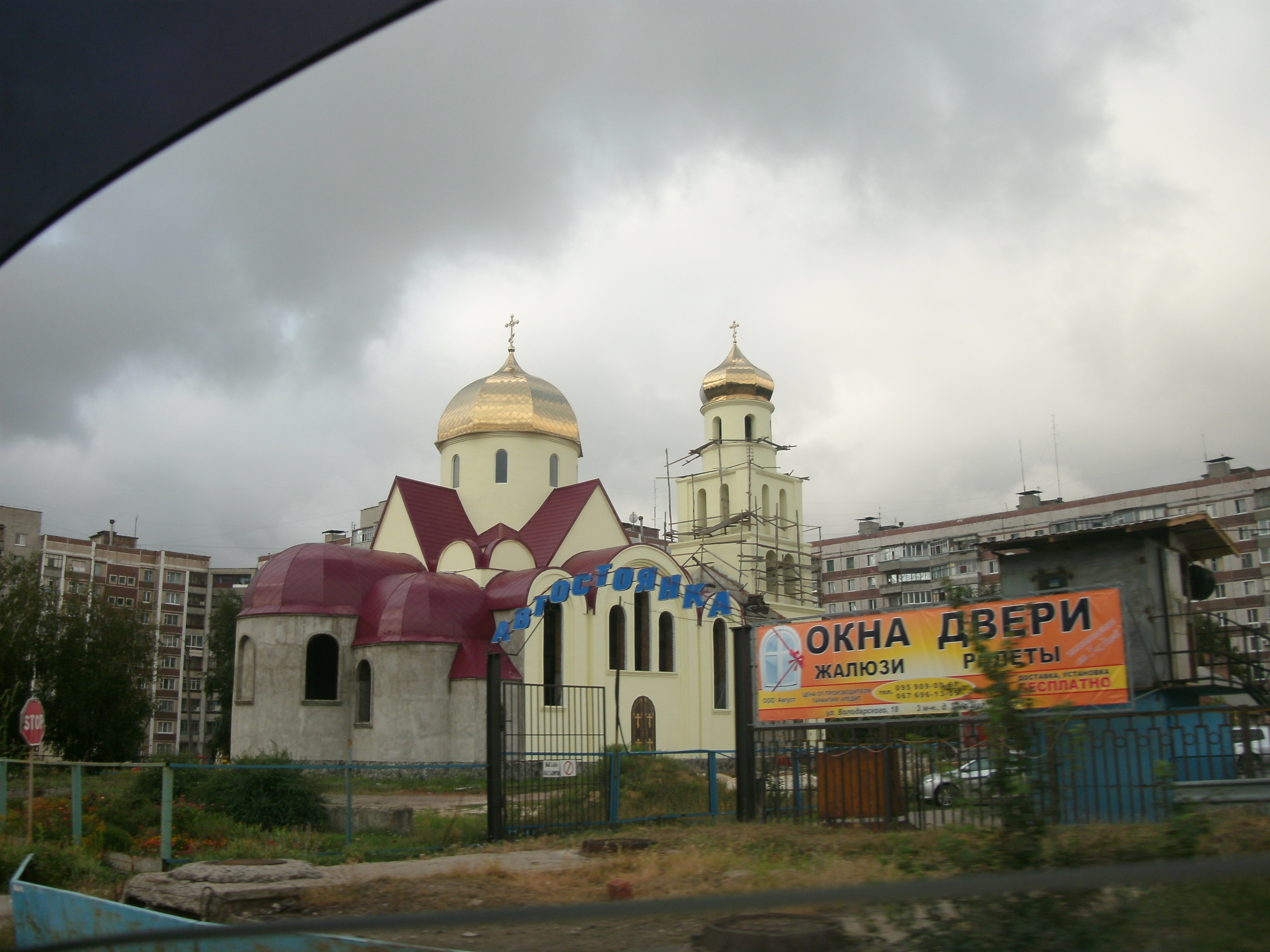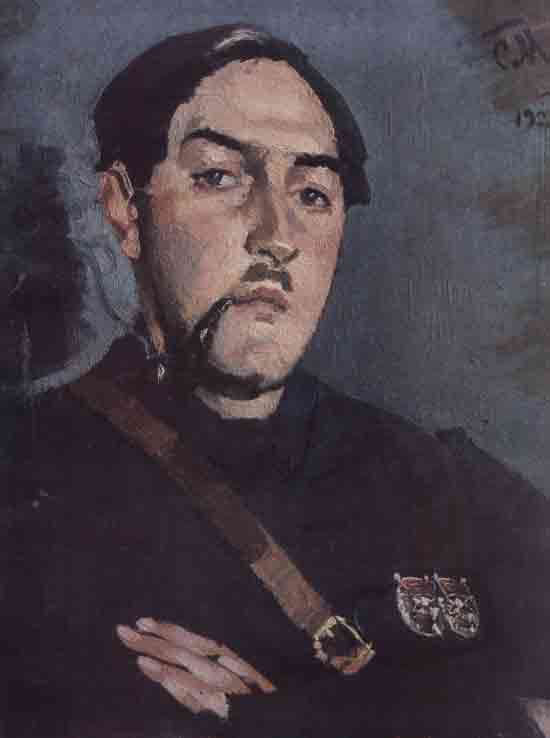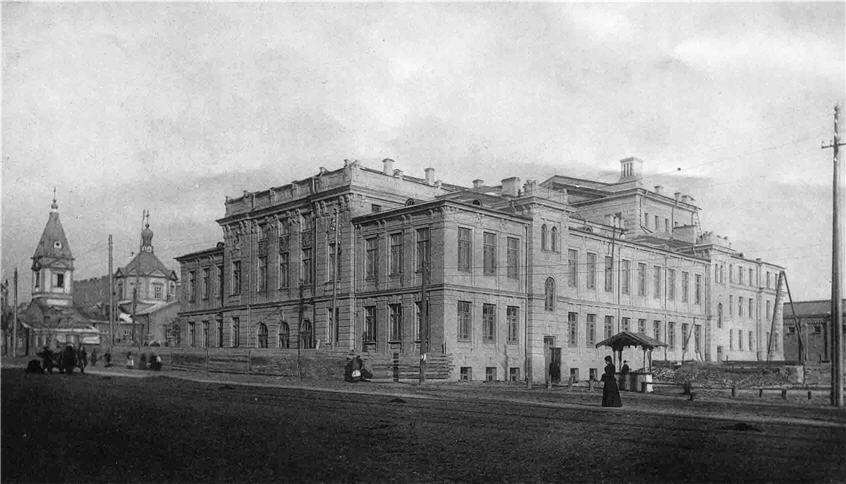|
Group Of Forces In Battle With The Counterrevolution In The South Of Russia
The Group of forces in battle with the counterrevolution in the South of Russia (russian: ąōčĆčāą┐ą┐ą░ ą▓ąŠą╣čüą║ ą┐ąŠ ą▒ąŠčĆčīą▒ąĄ čü ą║ąŠąĮčéčĆčĆąĄą▓ąŠą╗čÄčåąĖąĄą╣ ąĮą░ ą«ą│ąĄ ąĀąŠčüčüąĖąĖ) was a military formation of the Soviet Russian government created in the beginning of December 1917 to fight against various autonomous state formations (the Don Host Oblast and Ukrainian People's Republic) with a goal of establishing the Soviet government . The formation mainly consisted of Red Guard troops from Petrograd and Moscow under the command of Vladimir Antonov-Ovseyenko and Mikhail Muravyov as the chief of staff. The group consisted of some 20,000 troops. Historical background The group started to arrive in Kharkiv on December 21, 1917, and on December 22-23, 1917, with the help of the local squads of Red Guards, it established Soviet power in the city. On December 24-25, 1917 in Kharkiv the First All-Ukrainian Congress of Soviets, which proclaimed the Ukrainian People's Republic ... [...More Info...] [...Related Items...] OR: [Wikipedia] [Google] [Baidu] |
Ukrainian People's Republic Of Soviets
The Ukrainian People's Republic of Soviets (russian: ąŻą║čĆą░ąĖąĮčüą║ą░čÅ ąØą░čĆąŠą┤ąĮą░čÅ ąĀąĄčüą┐čāą▒ą╗ąĖą║ą░ ąĪąŠą▓ąĄč鹊ą▓, translit=Ukrainskaya Narodnaya Respublika Sovjetov) was a short-lived (1917ŌĆō1918) Soviet republic of the Russian SFSR that was created by the declaration of the Kharkiv All-Ukrainian Congress of Soviets "About the self-determination of Ukraine" on in the Noble Assembly building in Kharkiv. Headed by the Provisional Workers' and Peasants' Government of Ukraine formed earlier in Kursk. The republic was later united into the Ukrainian Soviet Republic and, eventually, liquidated, because of a cessation of support from the government of the Russian SFSR when the Treaty of Brest-Litovsk was signed. History Preparation of the All-Ukrainian congress of Soviets in Kyiv The idea to call for an All-Ukrainian Congress of Soviets was put forward by the Bolshevik faction within the executive committee of the Kyiv Council of workers' deputies during the united s ... [...More Info...] [...Related Items...] OR: [Wikipedia] [Google] [Baidu] |
Ukrainian People's Republic
The Ukrainian People's Republic (UPR), or Ukrainian National Republic (UNR), was a country in Eastern Europe that existed between 1917 and 1920. It was declared following the February Revolution in Russia by the First Universal. In March 1917, the National Congress in Kyiv elected the Central Council composed of socialist parties on the same principles as throughout the rest of the Russian Republic. The republic's autonomy was recognized by the Russian Provisional Government. Following the October Revolution, it proclaimed its independence from the Russian Republic on 22 January 1918 by the Fourth Universal. During its short existence, the republic went through several political transformations ŌĆō from the socialist-leaning republic headed by the Central Council of Ukraine with its general secretariat to the socialist republic led by the Directorate and by Symon Petliura. Between April and December 1918, the socialist authority of the Ukrainian People's Republic was sus ... [...More Info...] [...Related Items...] OR: [Wikipedia] [Google] [Baidu] |
Central Powers
The Central Powers, also known as the Central Empires,german: Mittelm├żchte; hu, K├Čzponti hatalmak; tr, ─░ttifak Devletleri / ; bg, ą”ąĄąĮčéčĆą░ą╗ąĮąĖ čüąĖą╗ąĖ, translit=Tsentralni sili was one of the two main coalitions that fought in World War I (1914ŌĆō1918). It consisted of the German Empire, Austria-Hungary, the Ottoman Empire, and the Kingdom of Bulgaria and was also known as the Quadruple Alliance.german: Vierbund, tr, D├Črtl├╝ ─░ttifak, hu, K├Čzponti hatalmak, bg, ą¦ąĄčéą▓ąŠčĆąĄąĮ čüčŖčÄąĘ, translit=Chetvoren s┼½yuz Colonies of these countries also fought on the Central Powers' side such as German New Guinea and German East Africa, until almost all of their colonies were occupied by the Allies. The Central Powers faced and were defeated by the Allied Powers that had formed around the Triple Entente. The Central Powers' origin was the alliance of Germany and Austria-Hungary in 1879. Despite having nominally joined the Triple Alliance before, Italy d ... [...More Info...] [...Related Items...] OR: [Wikipedia] [Google] [Baidu] |
Sloviansk
Sloviansk ( uk, ąĪą╗ąŠą▓'čÅąĮčüčīą║, Sloviansk ; russian: ąĪą╗ą░ą▓čÅąĮčüą║, Slavyansk or ; prior to 1784 ŌĆō Tor) is a city in the Kramatorsk district of the Donetsk region of Ukraine, the administrative center of the Slovyansk urban community. The city lies in the north of the region, in the valley of the Kazennyi Torets river. As of July 2022, the population of the city was around 24,000. Sloviansk was one of the focal points in the early stages of the 2014 pro-Russian conflict in Ukraine as it was the first city to be seized by Russia-backed military troops. It was retaken by Ukrainian forces in July 2014. Sloviansk has a population of . History The history of Sloviansk dates back to 1645 when Russian Tsar Alexis of Russia, Alexei Romanov founded a Zasechnaya cherta, border fortress named Tor against the Crimean-Nogai raids into East Slavic lands, Crimean attacks and slave raids on the southern suburbs of modern Ukraine and Russia. In 1664, a first salt plant for the e ... [...More Info...] [...Related Items...] OR: [Wikipedia] [Google] [Baidu] |
Pavlohrad
Pavlohrad (, ; , ) is a city and municipality in central east Ukraine, located within the Dnipropetrovsk Oblast. It serves as the administrative center of Pavlohrad Raion. Its population is approximately . The rivers of Vovcha (runs through the city towards the Samara River), Hnizdka (), Kocherha () flow through Pavlohrad. The area of the city is . There are 20 schools and 1 lyceum in the city. History Pavlohrad, one of the oldest modern settlements in the Dnipropetrovsk oblast appears in documents from the 17th century. At the beginning of the 1770s, Zaporozhian Cossack Matvii Khizhnyak built winter quarters, which soon became known as sloboda Matviivka ( ru , ą£ą░čéą▓ąĄąĄą▓ą║ą░ , translit = Matveevka). In 1779, Matveevka was renamed to Luhanske, as the latter became headquarters of the Luhansk pikemen regiment headed by M. I. Golinishchev-Kutuzov. With the establishment of Yekaterinoslav Viceroyalty in 1783, Pavlohrad, re-named in honor of the future Emperor Pa ... [...More Info...] [...Related Items...] OR: [Wikipedia] [Google] [Baidu] |
Synelnykove
Synelnykove (, ; , ) is a city and municipality in Synelnykove Raion, Dnipropetrovsk Oblast (province) of Ukraine, the largest city in the south-eastern part of the region. It serves as the administrative center of the raion. It is named after the Russian governor Ivan Sinelnikov. Population: History It was created as a settlement in Yekaterinoslav Governorate in the 19th century on a private territory that was given as a gift to the Russian governor Ivan Sinelnikov by the Russian Imperial government. During World War II, since October 1941 until September 1943 it was occupied by German troops. In January 1989 the population was 37 807 people In January 2013 the population was 31 568 people. Since 1979 and until 18 July 2020, Synelnykove was incorporated as a city of oblast significance and served as the administrative center of Synelnykove Raion though it did not belong to the raion. In July 2020, as part of the administrative reform of Ukraine, which reduced the number ... [...More Info...] [...Related Items...] OR: [Wikipedia] [Google] [Baidu] |
Lozova
Lozova ( uk, ąøąŠąĘąŠą▓ą░╠ü, ) or Lozovaya (russian: ąøąŠąĘąŠą▓ą░╠üčÅ) is a city in Kharkiv Oblast (province) of eastern Ukraine. It serves as the administrative center of the Lozova Raion (district). Lozova hosts the administration of Lozova urban hromada, one of the hromadas of Ukraine. Population: Lozova is the 2nd largest city in Kharkiv Oblast after Kharkiv in terms of population. History Lozova was founded in the late 1860s as a settlement in Kharkov Governorate of the Russian Empire.ąøąŠąĘąŠą▓ą░čÅ // ąæąŠą╗čīčłą░čÅ ąĪąŠą▓ąĄčéčüą║ą░čÅ ąŁąĮčåąĖą║ą╗ąŠą┐ąĄą┤ąĖčÅ. / ą┐ąŠą┤ čĆąĄą┤. ąÉ. ą£. ą¤čĆąŠčģąŠčĆąŠą▓ą░. 3-ąĄ ąĖąĘą┤. č鹊ą╝ 14. ą£., ┬½ąĪąŠą▓ąĄčéčüą║ą░čÅ čŹąĮčåąĖą║ą╗ąŠą┐ąĄą┤ąĖčÅ┬╗, 1973.ąøąŠąĘąŠą▓ą░čÅ // ąæąŠą╗čīčłą░čÅ ąĀąŠčüčüąĖą╣čüą║ą░čÅ ąŁąĮčåąĖą║ą╗ąŠą┐ąĄą┤ąĖčÅ / čĆąĄą┤ą║ąŠą╗ą╗., ą│ą╗. čĆąĄą┤. ą«. ąĪ. ą×čüąĖą┐ąŠą▓. č鹊ą╝ 17. ą£., ąĮą░čāčćąĮąŠąĄ ąĖąĘą┤ą░č鹥ą╗čīčüčéą▓ąŠ "ąæąŠą╗čīčłą░čÅ ąĀąŠčüčüąĖą╣čüą║ą░čÅ ąŁąĮčåąĖą║ą╗ąŠą┐ąĄą┤ąĖčÅ", 2011. čüčéčĆ.756 During the Russia ... [...More Info...] [...Related Items...] OR: [Wikipedia] [Google] [Baidu] |
Grigory Petrov
Grigory Constantinovich Petrov (russian: ąōčĆąĖą│ąŠčĆąĖą╣ ąÜąŠąĮčüčéą░ąĮčéąĖąĮąŠą▓ąĖčć ą¤ąĄčéčĆąŠą▓) (1892-20 September 1918) was a Russian Left Socialist-Revolutionary activist in Baku, Azerbaijan, during the Russian Civil War. Petrov became one of the 26 Baku Commissars of the Soviet Commune that was established in the city after the October Revolution. He was the Military Commissar of the Baku region. When the Commune was toppled by the Centro Caspian Dictatorship, a British-backed coalition of Dashnaks, SRs and Mensheviks, Petrov and his comrades were captured by British troops and executed by a firing squad Execution by firing squad, in the past sometimes called fusillading (from the French ''fusil'', rifle), is a method of capital punishment, particularly common in the military and in times of war. Some reasons for its use are that firearms are ... between the stations of Pereval and Akhcha-Kuyma of Transcaucasian Railroad on the night of 20 September 1918. Refere ... [...More Info...] [...Related Items...] OR: [Wikipedia] [Google] [Baidu] |
Pavel Yegorov
Pavel Vasilievich Yegorov (1889 ŌĆö 1965) was a Russian military leader during the war with Ukraine and the forces of Denikin. Born in 1889 in peasant family, during World War I Yegorov graduated a military college in Lyon, France, in 1915. In 1917 he joined Bolsheviks and was a member of Moscow Red Guards. In December 1917 Yegorov led his Red Guards to Ukraine along with the Antonov's expeditionary task force in fight with counter-revolution in the South Russia. He played a key role in taken Yekaterinoslav during the Yekaterinoslav Bolshevik Uprising and defeat of the Doroshenko Simferopol Regiment. In the beginning of 1918 his detachment grew into the 1st Revolutionary Army. In March - April 1918 Yegorov headed troops of the Russian Southern Front and later - the Vladikavkaz Military District. From summer of 1918 to spring of 1919 he was placed in charge of forces in combat area around Vladikavkaz to block off movement of the Denikin's troops. In summer of 1919, Yegorov led the ... [...More Info...] [...Related Items...] OR: [Wikipedia] [Google] [Baidu] |
Yuriy Sablin
Yuriy Vladimirovich Sablin (Russian: ą«čĆąĖą╣ ąÆą╗ą░ą┤ąĖą╝ąĖčĆąŠą▓ąĖčć ąĪą░ą▒ą╗ąĖąĮ; 24 November 1897 – 1937) was a Russian military leader and Socialist Revolutionary The Socialist Revolutionary Party, or the Party of Socialist-Revolutionaries (the SRs, , or Esers, russian: čŹčüąĄčĆčŗ, translit=esery, label=none; russian: ą¤ą░čĆčéąĖčÅ čüąŠčåąĖą░ą╗ąĖčüč鹊ą▓-čĆąĄą▓ąŠą╗čÄčåąĖąŠąĮąĄčĆąŠą▓, ), was a major politi .... Yuriy was born in Tartu, Yuryev, Governorate of Livonia, into a family of a book publisher Vladimir Sablin (1872-1916) and daughter of the Russian playwright Fyodor Korsh, Varvara. Yuriy Sablin studied at the Plekhanov Russian University of Economics, Moscow Commerce Institute and completed academic audit of the Moscow State University. In 1915 he joined the Socialist Revolutionary Party. During the World War I, in 1916 Sablin volunteered to army and served in artillery as a battery sergeant (vice-fireworker). He served at the Southwestern Front (Russian Empire ... [...More Info...] [...Related Items...] OR: [Wikipedia] [Google] [Baidu] |
Rudolf Sivers
Rudolf Ferdinandovich Sivers (1892ŌĆō1918) was a Russian revolutionary and military leader. Sivers was born in Saint Petersburg on 23 November 1892. A veteran of World War I, after the February Revolution he joined Bolshevik party and became a chief editor of "Entrenched Truth" newspaper in the 12th Army. At the end of July 1917 he was arrested by the Russian Provisional Government for defeatism, but was released during the October Revolution. At the start of the Russian Civil War, Sivers led Red Guards and sailors in the battle at Pulkovo against forces of KrasnovŌĆōKerensky. Soon thereafter in November 1917 along with his troops he was dispatched to Ukraine and the South Russia (Don River region). On 23 February 1918 Sivers' forces occupied Rostov-na-Donu and then Taganrog. In March ŌĆō April 1918 Sivers was put in charge of the 2nd Special Army (originally the 5th Army) and fought against the advancing forces of Central Powers near Kharkiv and Kupyansk despite the Treaty o ... [...More Info...] [...Related Items...] OR: [Wikipedia] [Google] [Baidu] |
All-Ukrainian Congress Of Soviets
The All-Ukrainian Congress of Soviets ( uk, ąÆčüąĄčāą║čĆą░茹Įčüčīą║ąĖą╣ ąĘ'茹ʹ┤ ąĀą░ą┤, russian: ąÆčüąĄčāą║čĆą░ąĖąĮčüą║ąĖą╣ čüčŖąĄąĘą┤ ąĪąŠą▓ąĄč鹊ą▓) was the supreme governing body of the Ukrainian Soviet Socialist Republic from 1917ŌĆō38. From 1922 to 1938 the Constitution of the Ukrainian SSR designated after the 1918 Russian Constitution mandated that Congress to be convened at least twice a year. The 1926 Constitution (in correspondence to all Soviet constitutions) lowered the minimum to once a year. In total there were 14 Congresses of Soviets that for the most of the time took place in Kharkiv. Description Following the end of the Russian Civil War and foreign military intervention, in Ukraine the ruling party of Bolsheviks continued actively to use the Soviet form of dictatorship of proletariat in its internal policy. [...More Info...] [...Related Items...] OR: [Wikipedia] [Google] [Baidu] |





